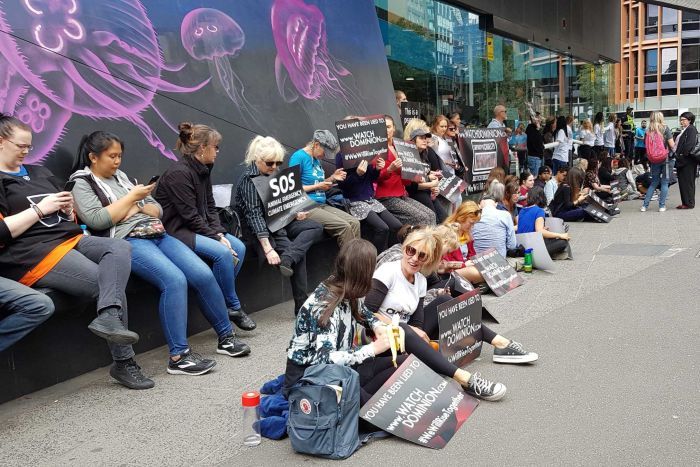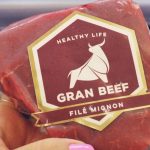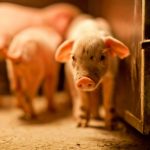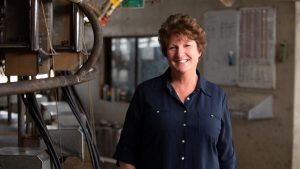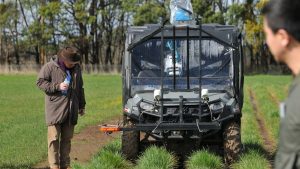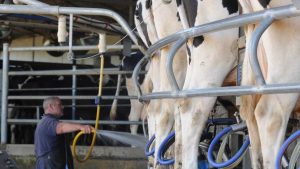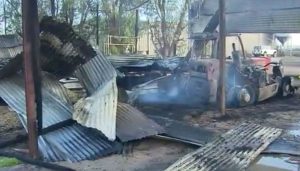
Police arrested 38 people, including three teenagers as young as 15 years old, who chained themselves to vans blocking the intersection of Flinders and Swanston streets, outside Flinders Street Railway Station.
Vegan Rising campaign director Kristin Leigh said the Flinders Street protest was one of nine planned around the country.
“We want people to go vegan, we want people to stop supporting animal abuse,” Ms Leigh said.
“I don’t believe any good person supports what’s happening in slaughterhouses and so-called farms today, these are places of exploitation of innocent vulnerable beings.
“Animals are suffering in ways that most of us could never imagine. It’s not about bigger cages, it’s about animal liberation.”
Victoria Police Superintendent David Clayton said the lack of prior engagement with police from protesters was disappointing, with the actions causing considerable disruptions to thousands of people attempting to navigate through the CBD during peak hour.
There was also a smaller group of activists who chained themselves at the entrance of the Melbourne Aquarium.
Justice For Captives member Chelsea Hannah said some protesters linked arms by placing their hands in plastic pipes to represent the plight of animals in captivity.
“Animals are not entertainment. Making profit under the guise of conservation is fundamentally wrong,” she said.
Dairy farmers near Warwick on Queensland’s Southern Downs said they were also confronted by activists outside their property about 6:30am, after they had left an earlier demonstration at an abattoir at Yangan.
Freestone farmer Jason Christensen said five or six cars pulled up near a herd of heifers and had scared the animals.
“We had about three heifers, they got out on the road, I don’t know how they got out on the road. When we tried to get them to put them back in they [protesters] were standing in the way,” Mr Christensen said.
“The heifers were scared and didn’t know what to do … one tried to jump in through the fence.
“Dad had the main confrontation with them — swearing at dad, trying to get at him — they were trying to tell him he should be growing vegetables.”
Activists arrested, abattoir owner to press charges
Earlier this morning, about 20 people chained themselves to equipment at the Yangan abattoir, south-west of Brisbane, while others had infiltrated abattoirs in Goulburn, New South Wales and in Laverton in Melbourne.
The protests were organised to mark the one-year anniversary of the release of the documentary Dominion, which looks into practices employed daily on Australian livestock farms.
NSW protesters allegedly broke into the Goulburn abattoir about 2:00am and had attached themselves to machinery with chains, taking police about an hour to cut them free.
Nine people were arrested and charged with trespass.
Queensland police confirmed no arrests were made against the protesters at Yangan, and all had left the property by 6:00am.
Police said negotiations were made between the protesters and the abattoir, and three sheep were handed over to the activists.
Farm Animal Rescue founder Brad King said the abattoir gave them the sheep so protesters would unchain themselves from equipment.
“We were asking for two things — one was for some animals to be rescued, which of course is great because that’s happened, but the primary thing we’re asking for is actually an improvement in the transparency of this industry,” he said.
Mr King said the animals would be cared for on his property at Dayboro, north of Brisbane.
“They’ll be in quarantine for a little while until we’re sure they’ve not brought any nasty infections with them, and then … they’ll get to spend the rest of their life with the rest of our herd here.
“Compared to the billions across the planet that are slaughtered every year, the number that sanctuaries can rescue is miniscule — the chance of an animal ending up in a place like this really is like winning the hardest lottery to win on the planet.”
Mr King said nationwide protests aimed to shine a light on the “abhorrent and hideous cruelty and terror that these animals suffer through”.
“Fundamentally, you’re dealing with everything from animals being slaughtered while they’re fully conscious, to animals just not being effectively stunned,” he said.
“All we’re asking for is an open and honest discussion about how these animals really are dealt with when they’re on farms and when they’re in slaughterhouses, so that consumers can make a real positive decision based on the information that they have when they go to the grocery store.”
‘Standover tactics are un-Australian’
But Carey Brothers abattoir owner, Greg Carey, said they were seeking legal advice and wished to press charges.
“I would like to put a stop to activists who I believe have no credibility,” Mr Carey.
“They are trying to bring our primary agricultural industry to its knees using standover tactics … this is un-Australian and harms the livelihood of many.”
Acting Inspector Jamie Deacon said no complaints had been made by landowners.
“The situation was resolved peacefully and without incident following negotiations between the management of the property and the activists,” Inspector Deacon said.
“The activists that were within the premises did have chains and padlocks … they left of their own accord.
“We had staff rostered specifically for the national day of action … it was a known event.”
No charges in Qld despite State Government ‘crackdown’
Queensland Deputy Opposition Leader Tim Mander has questioned why no one was arrested in Queensland, despite the State Government yesterday announcing a “crackdown” on activists who invade farms, with on-the-spot fines.
“Yesterday the Government made a big announcement but all it was, was a PR stunt,” Mr Mander said.
“The full weight of the law needs to be thrown at these people.
“Interstate we’ve seen that people have been arrested, but here in Queensland they’re not arrested and they actually take away three lambs. I mean it is a joke.”
Agriculture Minister Mark Furner said yesterday the penalties would be “severe” and “to the maximum” available, but stopped short of giving an amount for the fines and a timeframe of when they’d be introduced.
Today, Mr Furner told ABC Radio Brisbane that Queensland farms had some of the world’s best practices when dealing with animal welfare.
“It really distresses me, and I’m sure it does many of our farmers, the conduct of these people,” he said.
“I’ve really had a gutful of this mob and that’s why the Palaszczuk Government has introduced these strong measures of introducing regulations to crackdown on this behaviour.
“I must congratulate the police this morning for their efforts in monitoring this group of their illegal actions, invading our farmers.”
Last month more than 100 activists descended on a feedlot near Millmerran in Southern Queensland, taking photos and drone vision of cattle.
A spokesman for Green Shirts Movement Queensland, who represents farmers, said the protesters did not know the basics of how the animals live.
“Farmers follow the law, we’ve followed the law from go to whoa on this,” Martin Bella said.
Australian Meat Industry Council (AMIC) CEO Patrick Hutchinson called for a strong and rapid response from the Government, saying at least five AMIC member businesses were targeted in the invasions.
“What this amounts to is workers in regional and rural Australia being impacted by people who are not part of their communities,” Mr Hutchinson said.
“They come in, they cause trouble, they create images that are not representative of the work our members do, they damage a business’s ability to operate, and then they’re gone.”
Prime Minister Scott Morrison said those involved in the “indecent attacks” on farmers should be punished.
“I think state and territory governments should ensure that the full force of the law is brought against these green collared criminals,” he said.
